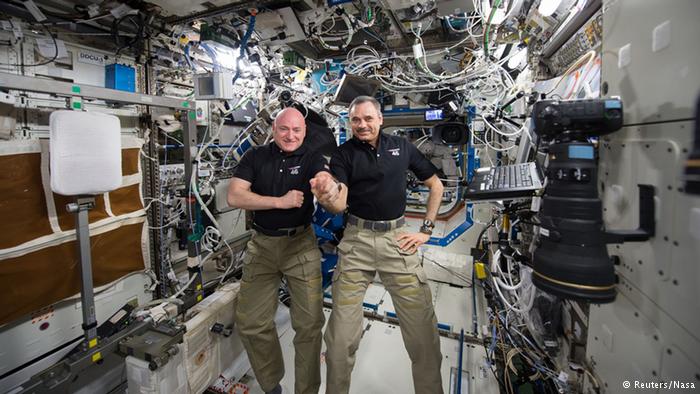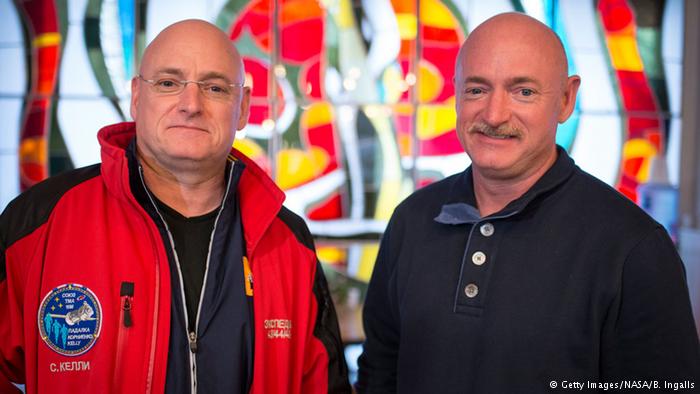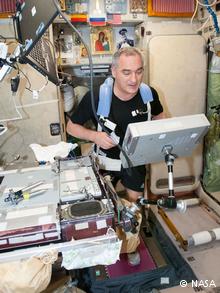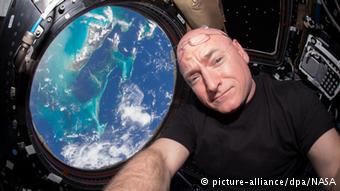Space
Medicine: What to bring long-term stays in space?
US Astronaut Scott Kelly and his Russian colleague Mikhail Korniyenko return after almost a year of the ISS. In addition to an ISS-long-term record, there are also interesting data for research.

ISS-record-holder Scott Kelly and Mikhail Korniyenko. Only cosmonauts on the Mir space station were no longer at the top.
27. March 2015, US Astronaut Scott Kelly and Russian cosmonaut Mikhail Kornienko aboard the Russian space ship Soyuz TMA-16M to the International space station (ISS) flown. Six hours later, they were able to dock already there. At the time, it was the 28. March at 1:33 PM world time. Since then, a clock is ticking for the both of them for a long-term record at All.
If everything goes according to Plan, they should land after about 340 days on the earth. In the night from Tuesday to Wednesday will close on the ISS, the hatch of their Soyuz capsule. Then it is in the Kazakh Bajkonur already Wednesday at 3:40 PM, in Central Europe Tuesday 22:40, and in the U.S. control center in Houston at 16:40. About six and a half hours later, the capsule will land in the Kazakh Steppe.
The last long-term record on the ISS had also set up a Russian-American Team: Mikhail Tyurin and Michael Lopez-Alegria were from 2006 to 2007 for 215 days on the space station. However, there were four Russian and Soviet spacemen, were still longer in All: an Absolute record holder among them, the Russian Valery Polyakov, who spent 437 days on the Mir space station from 1994 to 1995. The cosmonauts Sergei Avdeev, Vladimir Titov and Musa Manarov were longer in All than Kelly and Korniyenko.
A twin brother for comparison on the earth
New to the current Long-term test, however, is something that practitioners in such research projects usually can only dream of: you have an almost perfect comparison subjects on the earth. Scott Kelly has an identical twin brother. Mark Kelly is also an Astronaut and has participated as a Shuttle Pilot so far, in four space flights to the ISS.

Subject and comparison person – Scott and Mark Kelly at the farewell photo in front of the departure in March of 2015.
The twins are – and kidney – to heart, and much more examined in order to explore how the body and the organs in microgravity and on earth. The physicians of the body.
The research results from the long-term mission can help to understand what happens to astronauts, on the way to Mars – and not less important the findings are, however, for patients on earth.
The editorial recommends
Two months bed rest for research
Today, a long-time world begins in the Envihab of DLR space simulation. To do this, twelve subjects have to lie constantly in bed for two months – always with the head down. And, we swear! You do it voluntarily. (09.09.2015)
“The same Alexander Gerst as it was before”
Johann-Dietrich Wörner (Chairman of DLR) accompanied Alexander Gerst on Monday, a piece on his journey home, flew with him from Prestwick to Cologne. He took the time for a first interview – here are his impressions. (11.11.2014)
Self-sufficiency: gardening in space
The man wants to fly to Mars, he has a long journey ahead. For this he needs the food, but also oxygen to Breathe. He either takes everything or he builds it himself – in All. (05.08.2013)
As salt is harmful to the body
Salt causes high blood pressure – this is known. But why? The space brought to doctors now on the right track: salt, blood pressure, immune response and bone loss depend, obviously, closely. (23.07.2013)
What the universe does with the body
In Cologne a worldwide unique laboratory has opened. Subjects can be exposed to in the Envihab months of a change in the environment and can be observed, which is ideal for space travel, but also for medicine. (11.07.2013)
Forever on Mars
Who would leave his family behind, to live forever on Mars? Deutsche Welle spoke with one of the candidates of the “Mars One”Mission. Recently, he knows that He is aging on earth. (01.03.2015)
Changes in the bone substance
Because of the long stay in space can lead to bone loss. This goes hand in hand with a demineralizing The bone to be brittle and the inner substance weaker. After returning to earth, the risk of bone fractures is greater.
A similar Problem in women after the menopause. You will not be treated with medication, you can lose within one year over one percent of their bone tissue in the hip bone. In the case of astronauts, this is even faster: it can happen within a month. Strong bone losses also occur in the vertebrae, the thighs and the knee joints.
In contrast, it is limited somewhat by a specific diet to do. But here, too, the experience of previous space flights: astronauts ‘ food is generally a little less than on the earth, and lose up to five percent of their body weight.
Muscles back to form
Everyone knows it, if the Arm or leg were put in plaster a long time: After that, the Arm simply has no more strength. Any movement must first be learned. So the same goes for missions astronauts on Long-term. After only two weeks, the mass of muscle fibers decreases to about a third.
Due to the lack of gravity, the muscle groups are exactly that are responsible for ensuring that we walk, stand, and be able to sit upright. On earth, doctors can simulate the gravity-free condition by placing volunteers for months in a slight head-down position in the bed. This then has a similar effect.
Against the breakdown of muscle action, astronauts train in weightlessness regularly hard: every Day at least two hours on the treadmill, a treadmill or other exercise equipment. In the case of a long-term mission, they would lose up to forty percent of your muscle fibers.
Outside of space travel, the research may help to develop new therapies and treatment methods for bed – ridden patient and / or disease-related muscle loss.

Astronauts on the ISS can hold on to the treadmill fit. A shoulder strap replaces the gravity.
Other gravity other heart and circulatory
Because the body will lack in the hard-to-less effort, you will not be required the heart and the circulation, as on the earth. This, however, leads to less blood flow rate and thus to an under-supply to the muscles and organs with oxygen. In the case of a former astronaut again and again, heart rhythm disturbances have been detected, although they were actually in great shape.
In the absence of gravity, more blood flows in the torso and towards the head. The body responds by making less blood. The Astronaut returns to earth, he suffers first under low blood pressure. This can lead to the landing, up to fainting.
For physicians, the relationships between blood pressure and Gravitation are interesting – in addition to the associated molecular processes in the cells: Thus, it was on the previous room, there is a connection between salt flights in the diet and high blood pressure demonstrated. This is a separate area of research is growing up.
The immune system reacts to the weightlessness
From previous space flights, it is known that the human immune system changes in weightlessness. So a herpes infection, which would remain on the earth unnoticed, getting away on the space station suddenly.
Also, it was measured by samples, the number of immune cells in the blood, measured in front of us after a Mission, had changed. Already a short time after the return, these values returned to normal.
How come the person back into balance?
In the brain, information from a variety of nerves, run together: The eyes, the equilibrium organ in the inner ear, the sense of touch and of the nerve cells of the muscles. People get a sudden weightlessness, a lack of important orientation information. The senses get mixed up.
On the earth, the sea sickness is known as motion sickness, such as in Bus or car trips occurs. By electroencephalogram, and other diagnostic procedures, the physicians have to penetrate the astronauts the possibility of what is happening in the brain when you get used to the new state of the weightlessness and then after a long time, to the gravitational.

Cosmic radiation and particles from the sun can penetrate storms through the thin skin of the space station
What is the effect of the radiation on the body?
On earth, we are protected by the atmosphere from cosmic radiation. On the ISS, the protection exists only through the relatively thin outer wall of the space station – and which can not hold all of the ionizing radiation forms such as gamma radiation, which we know from the x-ray.
Add to this the particles that are thrown by the so-called coronal mass ejections from the sun – for example, penetrating protons.
Medical radiation risks: An increased risk of cancer, effects on the Central nervous system and damage to the genetic material.
The spirit and the nerve to stay strong?
Not only the gravity, also the Close on a space station, the good or sometimes bad mood in the Team and the workload can have an impact on health.
So lack of sleep can lead to measurable medical changes. This can be triggered by the noisy environment on a space station or a space ship, through the air conditioning or by the use of the stroke affected the day-night rhythm.
Astronauts sleep less than six hours a day, which can lead to the loss of efficiency. Due to the strict selection process, it is never a problems due to behavioral disturbances or psychosis came from.
It has been shown in previous ISS missions that the team skills of all the astronauts, for Mission success is important. The mood from the beginning is corrupted because of problems concealed or not addressed, can swings Anger over a long-term mission is also high.
